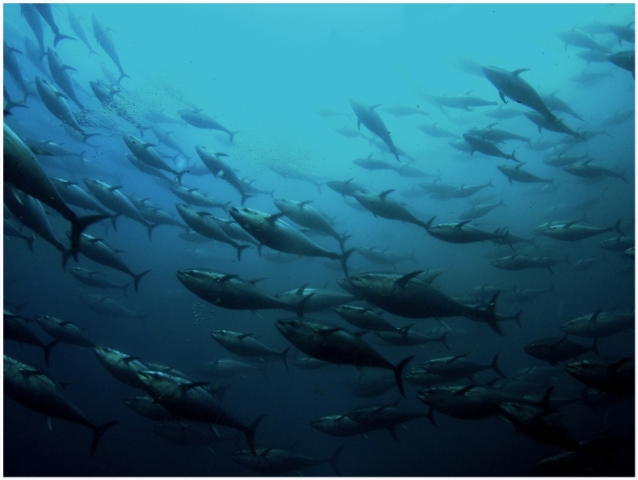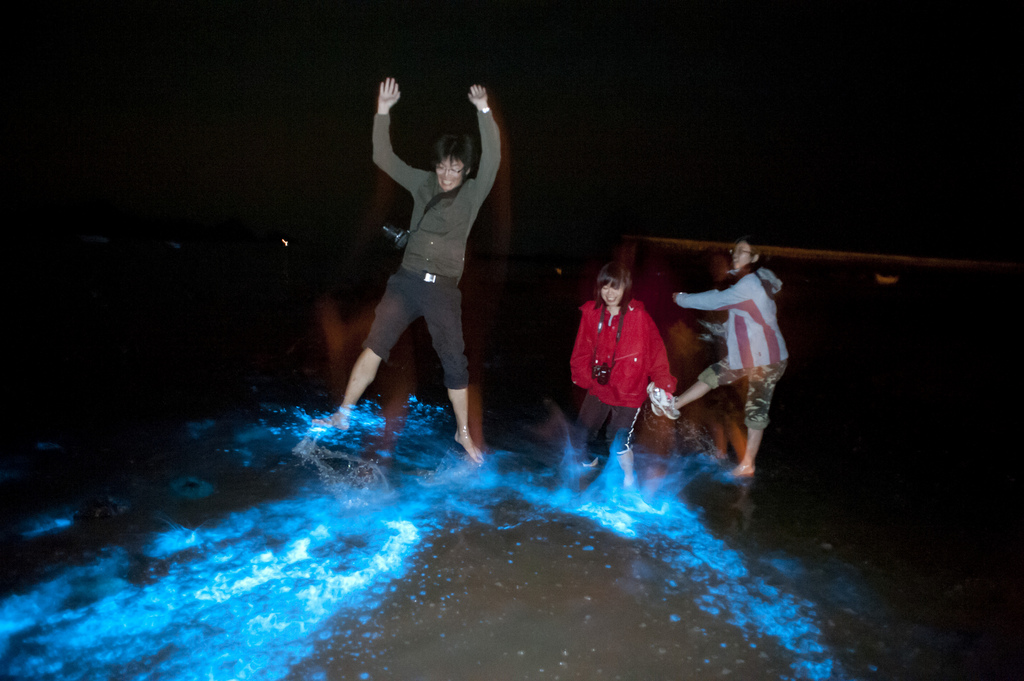Interactions and other species
Noctiluca scintillans is typically a heterotrophic organism which feeds on various types of diatoms such as Thalassiosira partheneia, Lauderia, and Rhizsolenia (Dela-Cruz et al. 2004). Noctiluca scintillans feeds on phytoplankton or their eggs, which would explain why this dinoflagellate tends to be found in greater density in areas with greater numbers of phytoplankton (Miyaguchi et al. 2006 and Dela-Cruz et al., 2004). Noctiluca scintillans, a predator itself, is not at the top of its food web. Zooplankton can prey on N. scintillans and other dinoflagellates, and studies suggest that Noctiluca scintillans uses bioluminescence as a defense mechanism from these types of predators (Buskey et al. 1992). Noctiluca scintillans is a positively buoyant dinoflagellate which feeds on other organisms via a process called interception feeding (Kiorbe and Titelman 1998). N. scintillans also feeds on bacteria and detritus that are present in its habitat (Miyaguchi et al. 2006). Noctiluca scintillans is a suspension feeder, and another example of a suspension feeder would be Ecteinascidia turbinata (Kiorbe and Titelman 1998).
Noctiluca scintillans is present in habitats across
many of the expansive bodies of water on Earth, therefore meaning
that there is a substantial number of symbioses with other
organisms. Noctiluca scintillans is known for being the
cause of red tides, but these tides do vary in appearance, such as
color (Dela-Cruz et al. 2004). In the coastal waters of
Southeast
Asia green prasinophyte endosymbionts can cause tides to create a
green color. Green is less common than a red color that is the
typical color change caused by blooms of N. scintillans
(Kiorbe and Titelman 1998). This endosymbiosis with algae mostly
occurs in tropical areas, although it is not that common (Kiorbe and
Titelman 1998 ). As previously mentioned in the habitat and
geography section, Noctiluca scintillans blooms can lead to
deoxygenation of surrounding waters. (Miyaguchi et al. 2006).
Deoxygenation can lead to the deaths of organisms such as
Pacific Halibut,
Chinook
Salmon, and
Pacific
Bluefin Tuna which have overlapping ranges with N.
scintillans. These fish and other organisms may die off in
large number which will have significant effects on the future of
the food web and the symbioses which organisms in these aquatic
habitats participate in. These die offs affects humans because there
is a consumer market for the consumption of these fish. Below is a
photo of a more playful interaction of Noctiluca scintillans
and humans using a longer than normal exposure time on the camera.
of red tides, but these tides do vary in appearance, such as
color (Dela-Cruz et al. 2004). In the coastal waters of
Southeast
Asia green prasinophyte endosymbionts can cause tides to create a
green color. Green is less common than a red color that is the
typical color change caused by blooms of N. scintillans
(Kiorbe and Titelman 1998). This endosymbiosis with algae mostly
occurs in tropical areas, although it is not that common (Kiorbe and
Titelman 1998 ). As previously mentioned in the habitat and
geography section, Noctiluca scintillans blooms can lead to
deoxygenation of surrounding waters. (Miyaguchi et al. 2006).
Deoxygenation can lead to the deaths of organisms such as
Pacific Halibut,
Chinook
Salmon, and
Pacific
Bluefin Tuna which have overlapping ranges with N.
scintillans. These fish and other organisms may die off in
large number which will have significant effects on the future of
the food web and the symbioses which organisms in these aquatic
habitats participate in. These die offs affects humans because there
is a consumer market for the consumption of these fish. Below is a
photo of a more playful interaction of Noctiluca scintillans
and humans using a longer than normal exposure time on the camera.

Interestingly enough, although Noctiluca scintillans is an interceptor feeder, the dinoflagellate and some of its prey are immotile (Kiorbe and Titelman 1998). Paradoxically, a dinoflagellate that cannot make any significant swimming movement is able to come across its immotile prey (Kiorbe and Titelman 1998). Noctiluca scintillans, being positively buoyant usually, uses buoyancy to its advantage by ascending up through the water column (Kiorbe and Titelman 1998). The water in close proximity to Noctiluca scintillans flows with enough turbulence to cause its prey to move in the water. This movement in combination with the ascension of the N. scintillans, allows the dinoflagellate to feed by intercepting its prey (Kiorbe and Titelman 1998). When populations of Noctiluca scintillans begin to starve, they grow in size which leads to faster ascent rates up the water column and allows for greater collection of food (Kiorbe and Titelman 1998). After Noctiluca scintillans comes close to its prey, there must be contact made to initiate feeding. The dinoflagellate has a small tentacle which it uses to take in possible food sources. Small parts of the prey can either be taken in through a mucus-covered part from making contact with the end of the tentacle (Kiorbe and Titelman 1998). Noctiluca scintillans feeds individually on its prey, rather than feeding in large groups (Kiorbe and Titelman 1998).
Now that you are more familiar with the interactions related to Noctiluca scintillans, let's move on to the Facts page. If you would like to start fresh on the website, please visit the Homepage.
